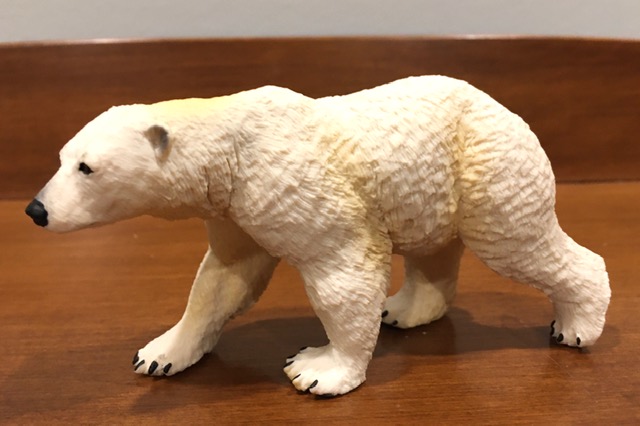Review and images by Suspsy; edited by bmathison1972
A truly iconic beast, the polar bear (Ursus maritimus) is the biggest of all extant bears, the undisputed master of the Great North, and the image on one side of the two dollar coin in my home and native land of Canada. 🙂 Due to its reliance on the Arctic sea ice, it is considered a marine mammal. Unfortunately, that same reliance has placed its future in serious doubt due to the ongoing effects of climate change.

Not surprisingly, a huge number of polar bear toys has been produced over the years, including this 2009 version from Safari Ltd. Measuring just under 13 cm long, it is posed in a walking stance with its head turned to the left, its right forepaw out in front, and its left hind paw raised in mid-step. Presumably it is lumbering across the frigid ice fields in search of prey. Unlike most other bears, polar bears are primarily carnivorous. Their most common prey are ringed, bearded, harp, and harbour seals, which are usually caught while resting on the ice or coming up to the water’s surface for air. Given the opportunity, they will also hunt beluga whales, narwhals, muskox, reindeer, and birds and their eggs, and scavenge on washed up bowhead whale carcasses. They will even attempt to take down walruses from time to time, but as I noted in my previous review, that can easily end badly for them!

As you’d expect, the main colour on this bear is creamy white with faint yellowish patches on the back of the neck, around the shoulder and hip joints, rump, and on the rump and the insides of the limbs. The insides of the ears are grey, the eyes are dark brown, and the nose, mouth, claws, and footpads are black. The paint has been applied rather sloppily to the sole of the right forepaw on mine, but at least it’s not visible when the toy is standing up.

This polar bear has all of the key features: a streamlined head with small ears, a relatively long neck and body, muscular limbs that can smash through ice to break into seal nursing dens, and large paws suitable for trekking long distances across snow and ice or swimming through the frigid Arctic waters. Polar bears are by far the best swimmers out of all the bears; they can dog paddle continuously for days with their body fat providing buoyancy. The black claws, which are used to hook the hides of seals before they can escape into the water, look sharp and deadly.

The detail on this polar bear is just as impressive. The nose features visible nostrils, the tiny eyes look ready and alert, the fur looks thick, shaggy, and realistic, and the musculature gives our bear an air of brute strength. Safari doesn’t specify its gender, but given that they also offer an endearing cub figure, it is very possible that this individual represents its mother. Female polar bears usually weigh around 150-200 kg (331-551 lbs), although it’s possible for them to grow bigger. Males can reach anywhere from 350-700 kg (772-1543 lbs) and stand more than three metres tall when on their hind legs. And the biggest recorded specimen was a whopping 1000 kg (2209 lbs). The only other bear that reaches that size is the mighty Kodiak, which has yet to receive a toy as far as I know!

But for all their size and strength, polar bears are currently in serious jeopardy due to climate change, which is rapidly depleting the Arctic ice which they have depended on for hundreds of thousands of years. Furthermore, it is highly dubious that they will be able to adapt easily to life on land, especially because they will be come into increased competition with grizzly bears. Although the polar bears have the advantage in size, they are more likely to retreat than stand and fight when confronted by an aggressive grizzly. Moreover, unlike a grizzly, a polar bear’s skull and dentition are ill-suited for consuming tough plant material. As a result, if climate change continues to go unchecked, polar bears are most likely going to be outcompeted by grizzlies both for food and living space.

Overall, this polar bear figure represents yet another homerun for Safari Ltd. It can usually be found wherever their products are sold. I just hope that it doesn’t someday fall into the same category as the woolly mammoth. There’s still time for us to prevent that.
Disclaimer: links to Ebay and Amazon on the AnimalToyBlog are affiliate links, so we make a small commission if you use them. Thanks for supporting us!




An impressive figure! When I started building my Synoptic Collection, I went with the Papo walking figure. I guess I hadn’t realized that Safari had updated theirs. While I don’t regret the Papo figure at all, if I had to start over, I might go with this one!
This is a very nice figure! I have the very similarly posed 1997 figure. It’s neat, but I’d say it doesn’t depict the weight of the fur as well as this one does.
As much as I like animals sculpted in neural, relaxed poses, I’d like to see Safari or CollectA or release another polar bear that’s standing up on its hind legs with its teeth bared. Grrrr!